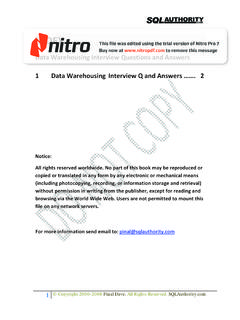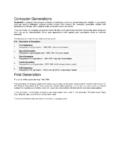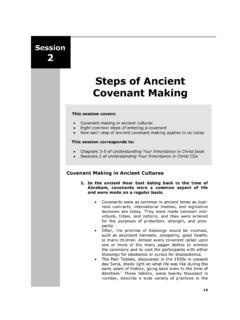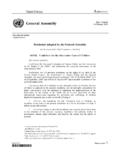Transcription of Types of Inheritance in Java Base Class
1 java NOTES ACHIN JAIN - ASSISTANT PROFESSOR, CSE(NIEC) java NOTES BY ACHIN JAIN 1 Inheritance Inheritance is the mechanism of deriving new Class from old one, old Class is knows as superclass and new Class is known as subclass. The subclass inherits all of its instances variables and methods defined by the superclass and it also adds its own unique elements. Thus we can say that subclass are specialized version of superclass. Benefits of java s Inheritance 1. Reusability of code 2. Code Sharing 3. Consistency in using an interface Classes Superclass( base Class ) Subclass(Child Class ) It is a Class from which other classes can be derived. It is a Class that inherits some or all members from superclass. Types of Inheritance in java 1. Single Inheritance - one Class extends one Class only base Class Child Class inherited from base Class . Note: extends keyword is used to inherit a sub Class from superclass. base Class Child Class java NOTES ACHIN JAIN - ASSISTANT PROFESSOR, CSE(NIEC) java NOTES BY ACHIN JAIN 2 2.
2 Multilevel Inheritance It is a ladder or hierarchy of single level Inheritance . It means if Class A is extended by Class B and then further Class C extends Class B then the whole structure is termed as Multilevel Inheritance . Multiple classes are involved in Inheritance , but one Class extends only one. The lowermost subclass can make use of all its super classes' members. 3. Hierarchical Inheritance - one Class is extended by many subclasses. It is one-to-many relationship. Example of Member Access and Inheritance Case 1: Member Variables have no access modifier (default access modifier) A B C A B C Variable i with no access modifier and we are using it in child Class . Program runs with no error in this case as members with default access modifier can be used in child Class Output java NOTES ACHIN JAIN - ASSISTANT PROFESSOR, CSE(NIEC) java NOTES BY ACHIN JAIN 3 Case 2: Member Variables have public/protected access modifier.
3 If a member of Class is declared as either public or protected than it can be accessed from child or inherited Class . Case 3: Member Variables have private access modifier. If a member of Class is declared as private than it cannot be accessed outside the Class not even in the inherited Class . Output: Variable j is declared as Private in Class inherit1 which means it cannot be accessed outside the Class scope. In the inherited Class an attempt to modify the value of a private variable is made which results in compile time error java NOTES ACHIN JAIN - ASSISTANT PROFESSOR, CSE(NIEC) java NOTES BY ACHIN JAIN 4 super Keyword: super is a reference variable that is used to refer immediate parent Class object. Uses of super keyword are as follows: 1. super() is used to invoke immediate parent Class constructors 2. super is used to invoke immediate parent Class method 3. super is used to refer immediate parent Class variable Example: Output: Example to call Immediate Parent Class Constructor using super Keyword The super() keyword can be used to invoke the Parent Class constructor as shown in the example below.
4 Note: super() is added in each Class constructor automatically by compiler. As default constructor is provided by compiler automatically but it also adds super() for the first statement. If you are creating your own constructor and you don t have super() as the first statement, compiler will provide super() as the first statement of the constructor. To print the value of base Class variable in a child Class use name This i will print value of local Class variable java NOTES ACHIN JAIN - ASSISTANT PROFESSOR, CSE(NIEC) java NOTES BY ACHIN JAIN 5 Output: Example where super() is provided by compiler Output: Method Overriding If a Class inherits a method from its super Class , then there is a chance to override the method provided that it is not marked final. The benefit of overriding is: ability to define a behavior that's specific to the subclass type which means a subclass can implement a parent Class method based on its requirement.
5 In object-oriented terms, overriding means to override the functionality of an existing method. Same program as above but no super keyword is used. You can see in the o/p below that compiler implicitly adds the super() keyword and same output is seen java NOTES ACHIN JAIN - ASSISTANT PROFESSOR, CSE(NIEC) java NOTES BY ACHIN JAIN 6 Ouput: Case When there is no method definition in child Class Output: meth1() method is overridden in the child Class . Now when meth1() method is invoked from object of child Class then compiler will first search for method definition in Class from which it is invoked. If method definition is not found then compiler will look for method definition in the parent Class . Method definition is not found in child Class , so compiler will now search in Parent Class . java NOTES ACHIN JAIN - ASSISTANT PROFESSOR, CSE(NIEC) java NOTES BY ACHIN JAIN 7 Final Keyword Final keyword can be used in the following ways: 1. Final Variable : Once a variable is declared as final, its value cannot be changed during the scope of the program 2.
6 Final Method : Method declared as final cannot be overridden 3. Final Class : A final Class cannot be inherited Example of Final Variable Output: Example of Final Method Variable i is declared as final In this code we are trying to modify the value of a Final Variable which will result in error as shown in the output In this example an attempt to override a final method (meth1()) is made which results in error java NOTES ACHIN JAIN - ASSISTANT PROFESSOR, CSE(NIEC) java NOTES BY ACHIN JAIN 8 Output Example of Final Class Output Dynamic Method Dispatch Dynamic method dispatch is the mechanism by which a call to an overridden method is resolved at run time, rather than compile time. Dynamic method dispatch is important because this is how java implements run-time polymorphism. Method to execution based upon the type of the object being referred to at the time the call occurs. Thus, this determination is made at run time. In other words, it is the type of the object being referred to (not the type of the reference variable) that determines which version of an overridden method will be executed.
7 java NOTES ACHIN JAIN - ASSISTANT PROFESSOR, CSE(NIEC) java NOTES BY ACHIN JAIN 9 Example Output Abstract Classes When the keyword abstract appears in a Class definition, it means that zero or more of its methods are abstract. An abstract method has no body. Some of the subclass has to override it and provide the implementation. Objects cannot be created out of abstract Class . Abstract classes basically provide a guideline for the properties and methods of an object. In this example a reference is created Ref1 of type parent1. To call an overridden method of any Class this reference variable is assigned an object of that Class . For ex. To call sum() method of child Class Ref1 is assigned object c1 of child Class . java NOTES ACHIN JAIN - ASSISTANT PROFESSOR, CSE(NIEC) java NOTES BY ACHIN JAIN 10 In order to use abstract classes, they have to be subclassed. There are situations in which you want to define a superclass that declares the structure of a given abstraction without providing a complete implementation of every method.
8 Example Output Since Method meth1() is declared as abstract it needs to be override in the inherited Class . However if the method is not overridden compile time error will be generated as shown below. java NOTES ACHIN JAIN - ASSISTANT PROFESSOR, CSE(NIEC) java NOTES BY ACHIN JAIN 11 Interface An interface is a collection of abstract methods. A Class implements an interface, thereby inheriting the abstract methods of the interface. An interface is not a Class . Writing an interface is similar to writing a Class , but they are two different concepts. A Class describes the attributes and behaviours of an object. An interface contains behaviours that a Class implements. Unless the Class that implements the interface is abstract, all the methods of the interface need to be defined in the Class . An interface is similar to a Class in the following ways: An interface can contain any number of methods. An interface is written in a file with a.
9 java extension, with the name of the interface matching the name of the file. The bytecode of an interface appears in a . Class file. Interfaces appear in packages, and their corresponding bytecode file must be in a directory structure that matches the package name. However, an interface is different from a Class in several ways, including: You cannot instantiate an interface. An interface does not contain any constructors. All of the methods in an interface are abstract. An interface cannot contain instance fields. The only fields that can appear in an interface must be declared both static and final. An interface is not extended by a Class ; it is implemented by a Class . An interface can extend multiple interfaces. Example to Create Interface As you can see in the above example method is not declared as abstract explicitly and similarly variable is not declared as static final. java NOTES ACHIN JAIN - ASSISTANT PROFESSOR, CSE(NIEC) java NOTES BY ACHIN JAIN 12 But when java compiles the code, method is declared as abstract implicitly by compiler and variables are declared as static final.
10 Example to implement interface Output Case: When definition of the method declared in interface is not provided in the inherited Class . In this case an error will be shown during compile time of the program. Output: Definition (Body) of the function salary() declared in the interface emp increment is the variable declared in interface. Value of the variable is 10. java NOTES ACHIN JAIN - ASSISTANT PROFESSOR, CSE(NIEC) java NOTES BY ACHIN JAIN 13 Case: Try to modify the value of variable declared in interface Output How Interface provide Multiple Inheritance in java In the above example, two interfaces are created with names emp and director and both interfaces contain same method salary(). In the Class interfacetest we have implemented both the interfaces. Now as per the definition of interface a method java NOTES ACHIN JAIN - ASSISTANT PROFESSOR, CSE(NIEC) java NOTES BY ACHIN JAIN 14 declared must be overridden in the Class that implements the interface.











